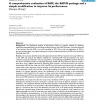BMCBI
2004
14 years 6 months ago
2004
Background: Two or more factor mixed factorial experiments are becoming increasingly common in microarray data analysis. In this case study, the two factors are presence (Patients...
BMCBI
2005
14 years 6 months ago
2005
Background: Many cutting-edge microarray analysis tools and algorithms, including commonly used limma and affy packages in Bioconductor, need sophisticated knowledge of mathematic...
BMCBI
2006
14 years 7 months ago
2006
Background: Raw data normalization is a critical step in microarray data analysis because it directly affects data interpretation. Most of the normalization methods currently used...
CSDA
2010
14 years 7 months ago
2010
An approximate rank revealing factorization problem with structure constraints on the normalized factors is considered. Examples of structure, motivated by an application in micro...
BMCBI
2008
14 years 7 months ago
2008
Background: Normalization is essential in dual-labelled microarray data analysis to remove nonbiological variations and systematic biases. Many normalization methods have been use...
BMCBI
2007
14 years 7 months ago
2007
Background: Gene expression microarray is a powerful technology for genetic profiling diseases and their associated treatments. Such a process involves a key step of biomarker ide...
BMCBI
2007
14 years 7 months ago
2007
Background: The Significance Analysis of Microarrays (SAM) is a popular method for detecting significantly expressed genes and controlling the false discovery rate (FDR). Recently...
BMCBI
2008
14 years 7 months ago
2008
Background: Though microarray experiments are very popular in life science research, managing and analyzing microarray data are still challenging tasks for many biologists. Most m...
BMCBI
2008
14 years 7 months ago
2008
Background: Microarray experimentation requires the application of complex analysis methods as well as the use of non-trivial computer technologies to manage the resultant large d...
BIOCOMP
2006
14 years 8 months ago
2006


